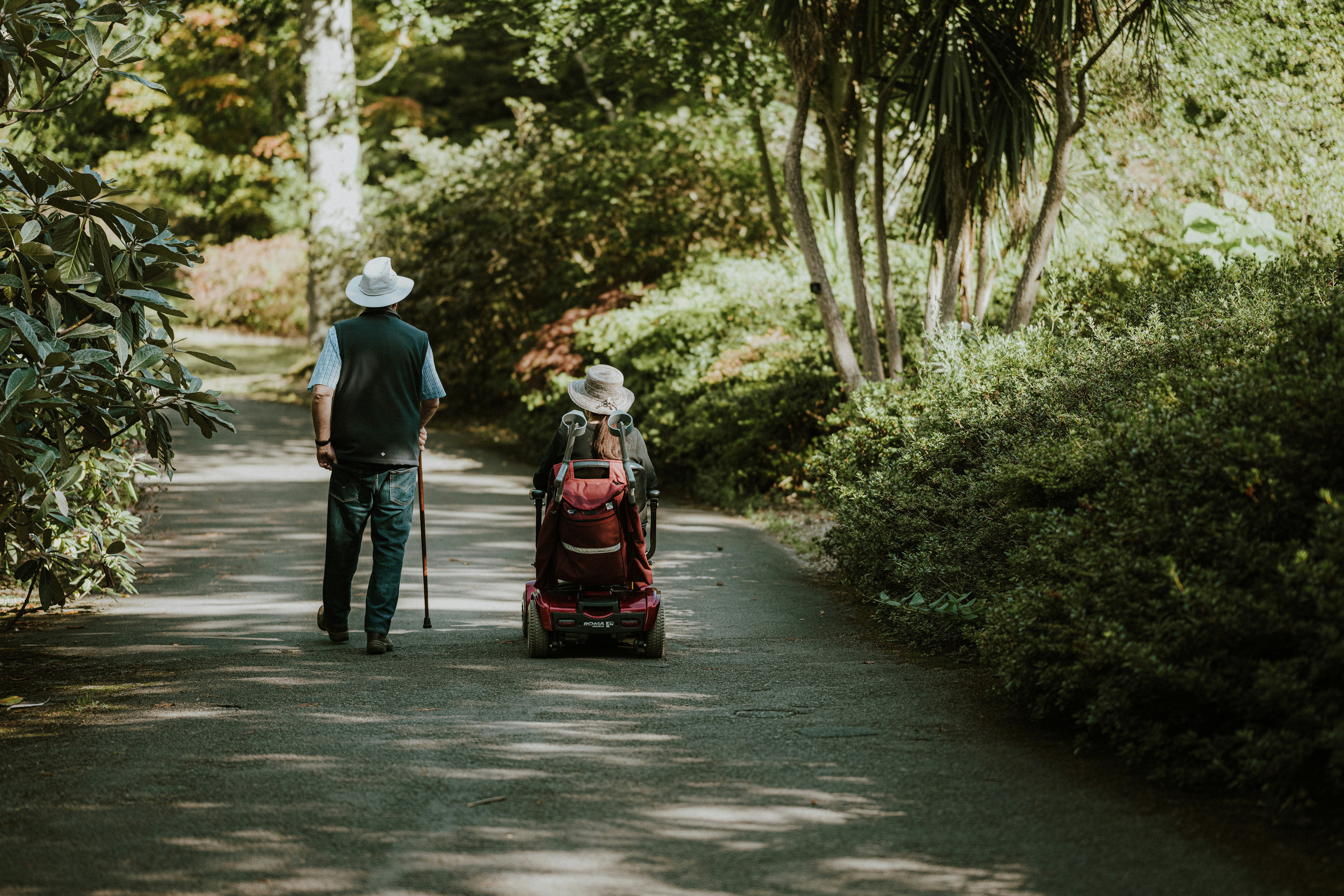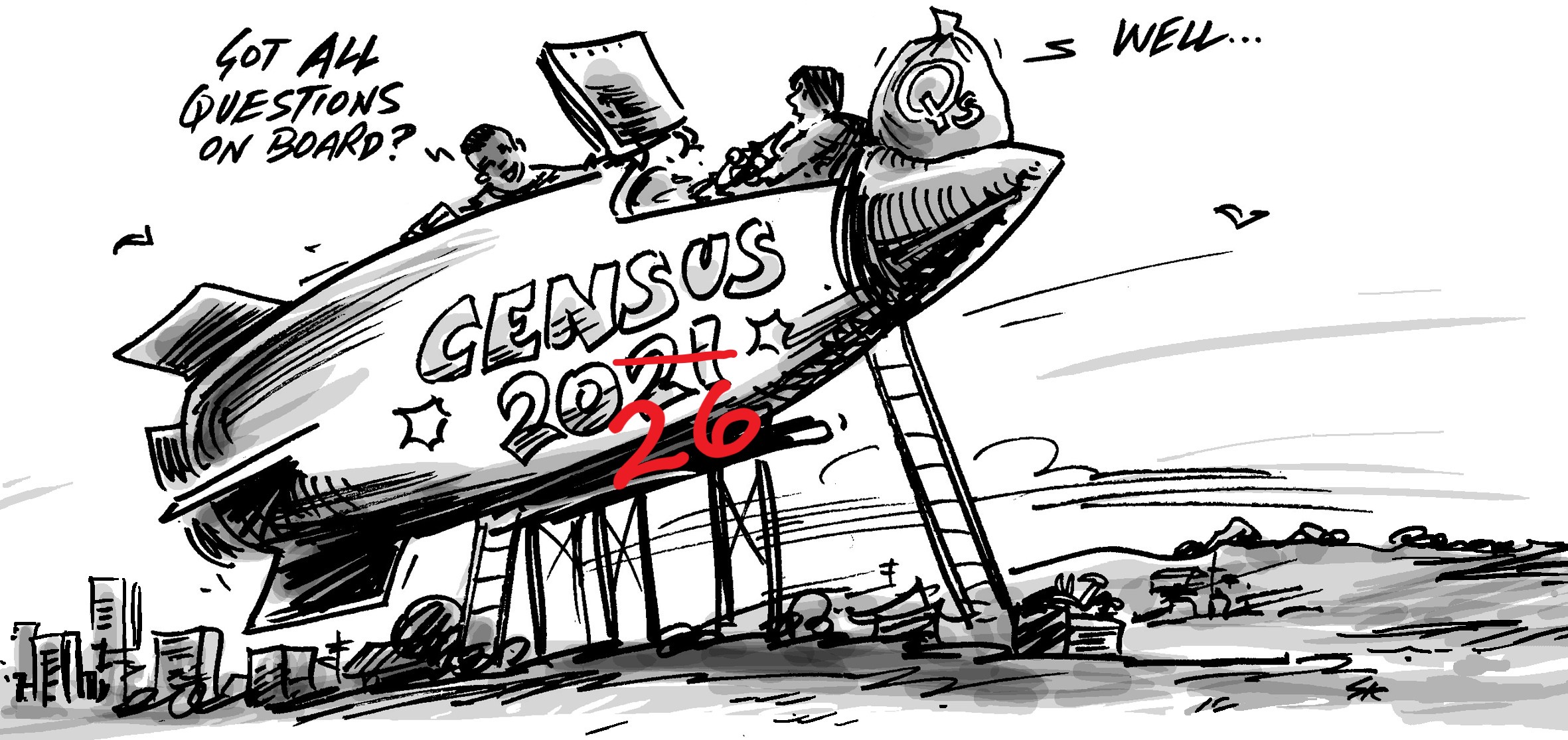In my final blog on religion in the Census, I will focus on how particular religious affiliations are distributed around Australia. Religion is strongly associated with cultural background, and the breakdown of these religions can reveal how particular groups are moving within our cities, and also something about our history.

Catholic
Still the largest single religious group in Australia, and one of the few mainstream religions to show growth from 2006-2011, Catholicism is the largest religion in many areas. It tends to be dominant in older working class areas of our cities, especially where those areas have not gone too far down the road of gentrification, and where there are concentrations of older immigrants, particularly Italians. At the state level, NSW (27.0%) and Victoria (26.6%) have the highest percentages of Catholics.
The ten Local Government Areas (LGA) with the highest proportions of Catholics are:
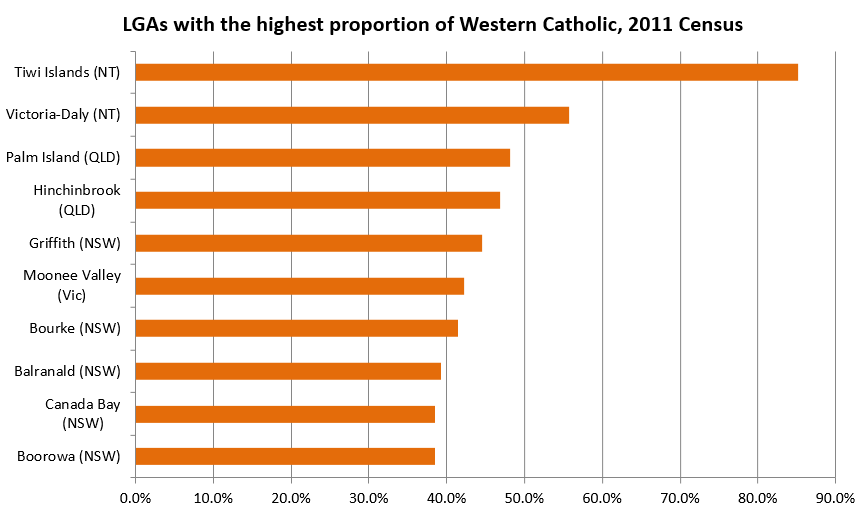
Please note: In calculating the top 10 Local Government Areas (LGAs) for each religion, I have excluded very small LGAs with less than 1,000 people.
The first four are predominantly aboriginal communities in the Northern Territory and Queensland, while the remainder are in capital cities (Moonee Valley, Canada Bay) or regional areas (Griffith, Balranald) with a high proportion of Italian migration in the post WWII period.
Anglican
The main protestant religion in Australia, most Anglicans naturally have their ancestry in England. This group declined significantly over the past 20 years. Traditionally dominant in the more affluent suburbs of Sydney, Melbourne and Adelaide, these are the main areas where Anglicans have lost adherents to “No Religion”. Anglican remains a dominant religion in many rural areas, particularly northern NSW and regional Queensland, the WA wheatbelt, most of Tasmania and parts of Perth with large UK-born populations. At a state level, Tasmania has by far the highest proportion, with 26.0%, followed by NSW with 19.9%.
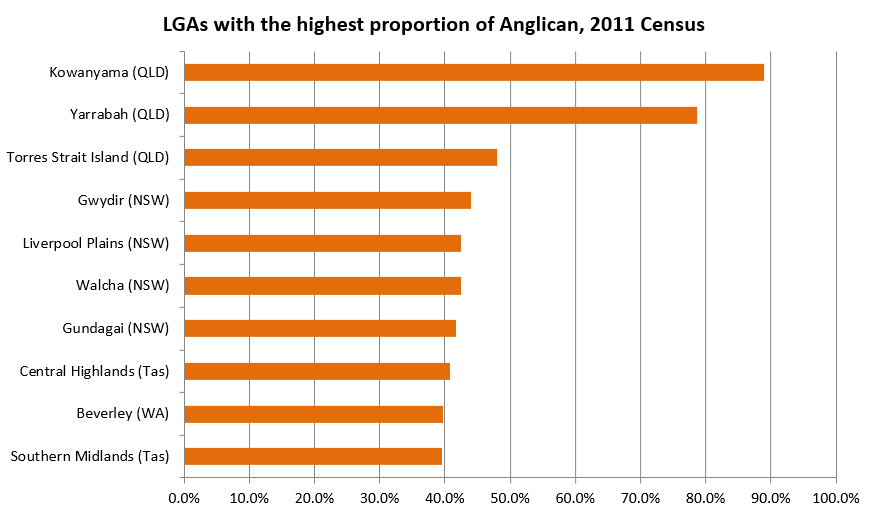
Again, the top 3 LGAs for percentage of Anglicans are small aboriginal communities in Queensland. It’s worth remembering that these are fairly small in absolute number of people (though I have removed LGAs with populations under 1,000, these communities are only slightly larger). This same trend is seen when you rank LGAs by many of the Christian denominations – small remote indigenous communities top the list in many cases (but different communities for each denomination). Presumably this relates to the location of religious missions over the last century and a half.
Buddhism
Buddhism has been a growing religion in Australia for several decades, driven by immigration from various Asian countries (particularly Vietnam and Cambodia), and its popularity as an “alternative” religion among the Australian-born.
At the state level, NSW and Victoria (2.9% and3.1% respectively) have the highest percentages, and the top 10 LGAs for Buddhism are all in Melbourne and Sydney, with the top of the list representing the major areas of Vietnamese migration.
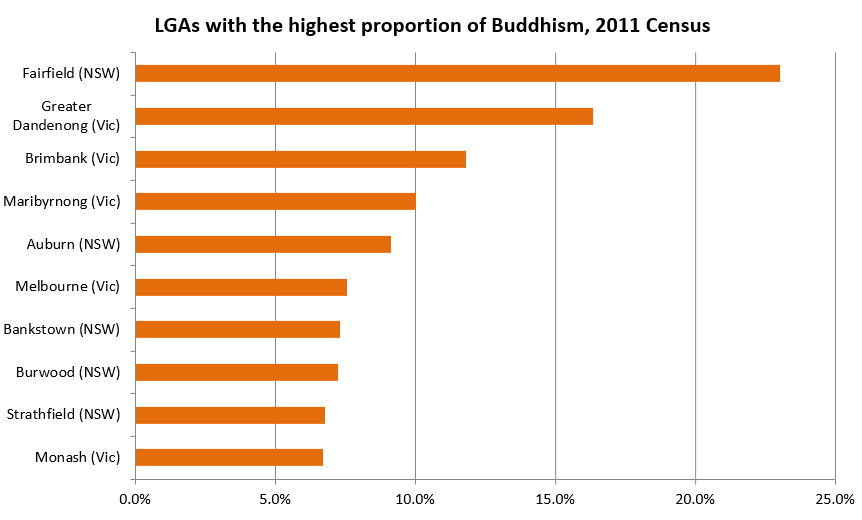
Hinduism
Hinduism was one of the fastest growing religions in the 2006-2011 period, due to the huge influx of Indian migration. Hindus now make up 1.3% of the nation, with NSW, Victoria and the ACT each having about 1.7%.
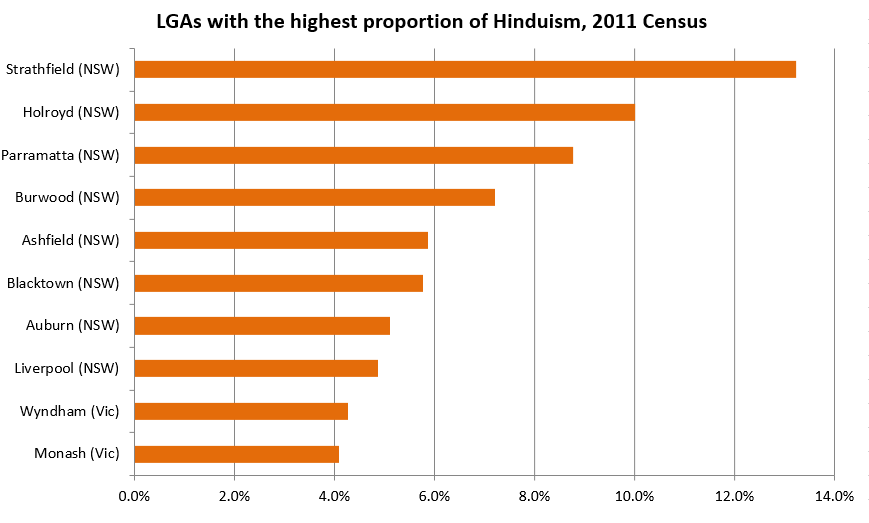
The top 10 LGAs for Hinduism reveal the complete dominance of Sydney and Melbourne as home for this migrant group. The interesting thing is that while Victoria and NSW had very similar proportions of Hindus overall, the top 8 LGAs are all in Western Sydney, another illustration of the highly concentrated nature of multicultural communities in Sydney compared to other parts of the country.
Islam
Islam was the faith of 2.2% of Australia’s population in 2011 and is growing, driven by migration from countries such as Egypt, Iraq, Iran, Syria and Turkey. Like the other non-Christian religions, Victoria and NSW contain the bulk of this population, but there are growing numbers in WA.
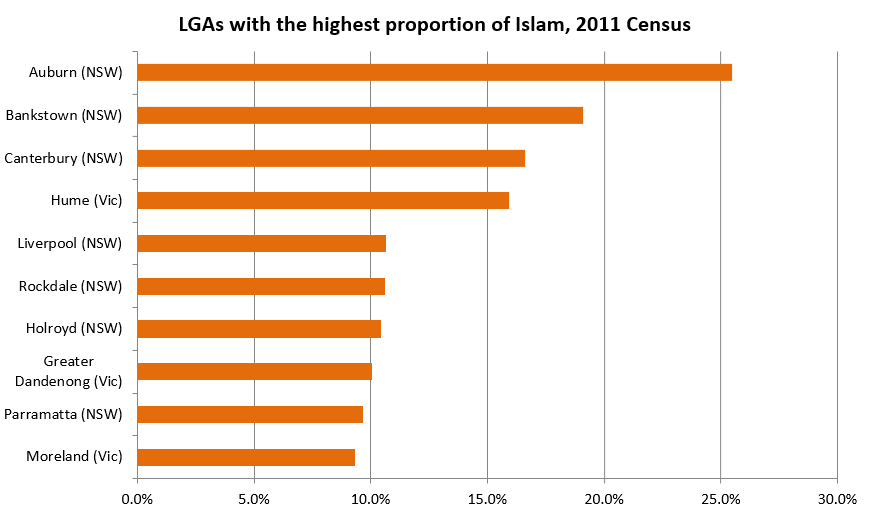
The top 10 LGA list for Islam is again dominated by Western Sydney, particularly Auburn (25.5%) and Bankstown (19.1%), as well as the main migration areas in Melbourne – Moreland, Dandenong and Hume. The Islamic population is quite highly concentrated in these areas.
Judaism
More than any other religion, Judaism is highly localised in particular regions – the affluent inner southern suburbs of Melbourne and the eastern suburbs of Sydney in particular. Judaism makes up only 0.5% of the Australian population all up.
No religion
The increase in “No Religion” was the biggest story in the 2011 Census. In general, no religion is strongest in areas with high number of young adults (religious belief increases with age), and particularly young males (eg. mining areas). It is increasing its share of the population largely at the expense of the mainstream protestant religions (Anglican, Uniting, Lutheran), and may well be a reflection of the low church attendance among these denominations, and people now marking “No Religion” where they would previously have marked the religion of their birth, even if they were not practicing. No Religion does not necessarily indicate Atheism but does indicate that the person does not belong to any organised church or subscribe to any particular religious belief.
At the state level, NSW has by far the lowest proportion of No Religion (17.9%), and Tasmania (28.6%), the ACT (28.9%) and South Australia (28.1%) have the highest.
The top 10 LGAs list for No Religion doesn’t have a clear pattern, but does include inner suburban areas (Yarra, Leichhardt, Hobart), alternative lifestyle regional areas (Byron, Mount Alexander, Adelaide Hills) and mining areas with a high proportion of young males (Denmark, Exmouth). Other inner city areas with a high proportion of young people such as the cities of Adelaide, Melbourne, Sydney and Fremantle appear just outside the top 10.
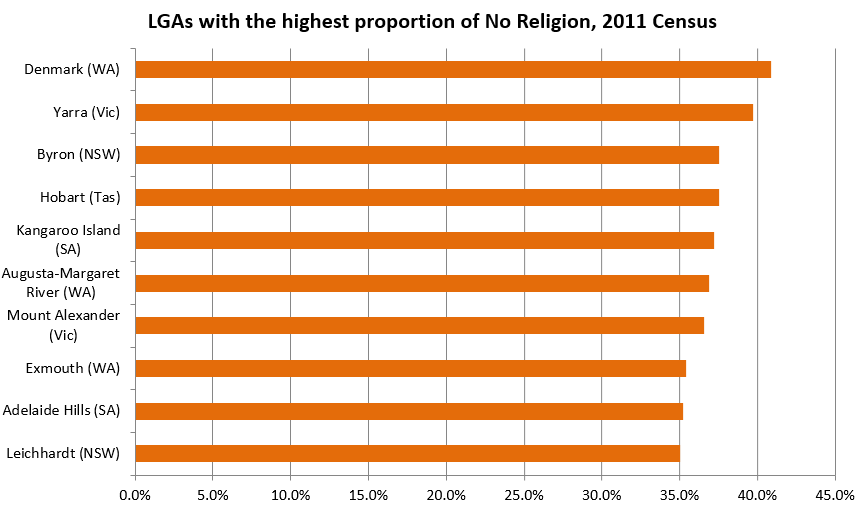
Religion data for Australia
If you would like any of the raw data which went into this blog, drop me a line and I’ll send it to you. Much of the data is in profile.id as well, going online soon.
Access more information about the Australian Census 2011.










